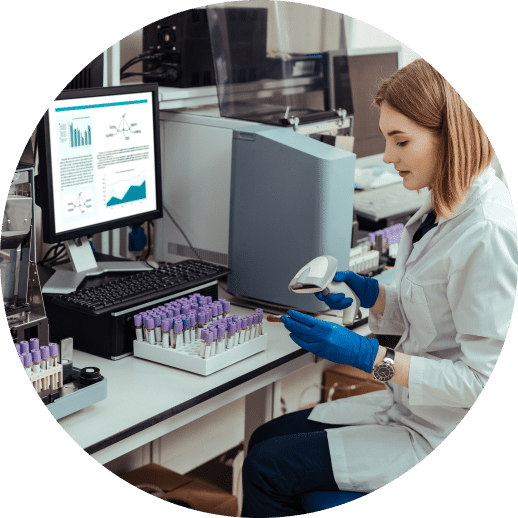Clinical Indication ID & Name
Growth failure in early childhood
Test Group
Endocrinology
Specialties
Test code
R147.1
Test name
N/A
Target genes
Growth failure in early childhood (473)
Test scope
n/a
Test method/ technology
WES or Medium Panel
Optimal Family Structure
n/a
Eligibility Criteria
Height/length more than 3 standard deviations below the mean at the age of at least 2 years in the absence of microcephaly, OR
Clinical features strongly indicative of a diagnosis of Silver-Russell syndrome, as assessed by the presence of 3 or more of the features below*:
1. SGA (birth weight and/or birth length): ≤−2 SDS for gestational age
2. Postnatal growth failure: Height at 24 ± 1 months ≤−2 SDS or height ≤−2 SDS below mid-parental target height
3. Relative macrocephaly at birth: Head circumference at birth ≥1.5 SDS above birth weight and/or length SDS
4. Protruding forehead: Forehead projecting beyond the facial plane on a side view as a toddler (1–3 years)
5. Body asymmetry: Leg length discrepancy of ≥0.5 cm or arm asymmetry or leg length discrepancy <0.5 cm with at least two other asymmetrical body parts (one non-face)
6. Feeding difficulties and/or low BMI: BMI ≤−2 SDS at 24 months or current use of a feeding tube or cyproheptadine for appetite stimulation
*See Wakeling et al 2017, PMID: 27585961
Test code
R147.2
Test name
N/A
Target genes
11p15 imprinted growth regulatory region and UPD7 growth regulatory critical region
Test scope
n/a
Test method/ technology
Methylation testing
Optimal Family Structure
n/a
Eligibility Criteria
Height/length more than 3 standard deviations below the mean at the age of at least 2 years in the absence of microcephaly, OR
Clinical features strongly indicative of a diagnosis of Silver-Russell syndrome, as assessed by the presence of 3 or more of the features below*:
1. SGA (birth weight and/or birth length): ≤−2 SDS for gestational age
2. Postnatal growth failure: Height at 24 ± 1 months ≤−2 SDS or height ≤−2 SDS below mid-parental target height
3. Relative macrocephaly at birth: Head circumference at birth ≥1.5 SDS above birth weight and/or length SDS
4. Protruding forehead: Forehead projecting beyond the facial plane on a side view as a toddler (1–3 years)
5. Body asymmetry: Leg length discrepancy of ≥0.5 cm or arm asymmetry or leg length discrepancy <0.5 cm with at least two other asymmetrical body parts (one non-face)
6. Feeding difficulties and/or low BMI: BMI ≤−2 SDS at 24 months or current use of a feeding tube or cyproheptadine for appetite stimulation
*See Wakeling et al 2017, PMID: 27585961
Test code
R147.3
Test name
N/A
Target genes
Genomewide
Test scope
n/a
Test method/ technology
Microarray
Optimal Family Structure
n/a
Eligibility Criteria
Height/length more than 3 standard deviations below the mean at the age of at least 2 years in the absence of microcephaly, OR
Clinical features strongly indicative of a diagnosis of Silver-Russell syndrome, as assessed by the presence of 3 or more of the features below*:
1. SGA (birth weight and/or birth length): ≤−2 SDS for gestational age
2. Postnatal growth failure: Height at 24 ± 1 months ≤−2 SDS or height ≤−2 SDS below mid-parental target height
3. Relative macrocephaly at birth: Head circumference at birth ≥1.5 SDS above birth weight and/or length SDS
4. Protruding forehead: Forehead projecting beyond the facial plane on a side view as a toddler (1–3 years)
5. Body asymmetry: Leg length discrepancy of ≥0.5 cm or arm asymmetry or leg length discrepancy <0.5 cm with at least two other asymmetrical body parts (one non-face)
6. Feeding difficulties and/or low BMI: BMI ≤−2 SDS at 24 months or current use of a feeding tube or cyproheptadine for appetite stimulation
*See Wakeling et al 2017, PMID: 27585961
Test code
R147.4
Test name
N/A
Target genes
Growth failure in early childhood (473)
Test scope
n/a
Test method/ technology
Exon level CNV detection by MLPA or equivalent
Optimal Family Structure
n/a
Eligibility Criteria
Height/length more than 3 standard deviations below the mean at the age of at least 2 years in the absence of microcephaly, OR
Clinical features strongly indicative of a diagnosis of Silver-Russell syndrome, as assessed by the presence of 3 or more of the features below*:
1. SGA (birth weight and/or birth length): ≤−2 SDS for gestational age
2. Postnatal growth failure: Height at 24 ± 1 months ≤−2 SDS or height ≤−2 SDS below mid-parental target height
3. Relative macrocephaly at birth: Head circumference at birth ≥1.5 SDS above birth weight and/or length SDS
4. Protruding forehead: Forehead projecting beyond the facial plane on a side view as a toddler (1–3 years)
5. Body asymmetry: Leg length discrepancy of ≥0.5 cm or arm asymmetry or leg length discrepancy <0.5 cm with at least two other asymmetrical body parts (one non-face)
6. Feeding difficulties and/or low BMI: BMI ≤−2 SDS at 24 months or current use of a feeding tube or cyproheptadine for appetite stimulation
*See Wakeling et al 2017, PMID: 27585961
Commissioning group
Specialised
Overlapping idications
• R88 Severe microcephaly test should be used for patients with primary microcephaly – microcephalic dwarfism spectrum. • R52 Short stature – SHOX deficiency test should be used where only a microarray is required • R159 Pituitary hormone deficiency test should be used where more than one pituitary hormone is deficient as the cause of growth failure • R104 Skeletal dysplasia should be considered if overlapping features are present and should be used where clinical features indicative of a likely monogenic skeletal dysplasia • R28 Congenital malformation and dysmorphism syndromes – microarray only
Address for samples/request forms
North Thames GLH, Rare & Inherited Disease Genomic Laboratory
Specimen Reception, Level 5 Barclay House, 37 Queen Square,
London WC1N 3BH
Contact with queries
Supporting documents
Rare Disese WGS Clinician pack
Education resources
n/a
Service updates
n/a
Request form download
Consent record
See consent guidance in test request form
Sample requirements
See sample guidance in test request form
